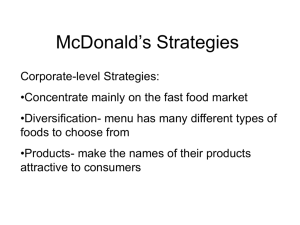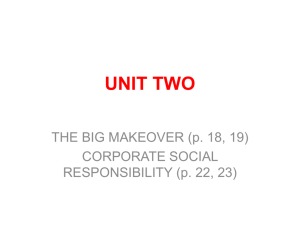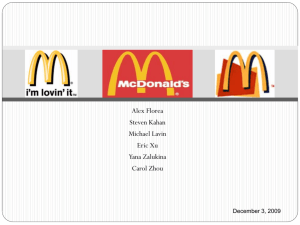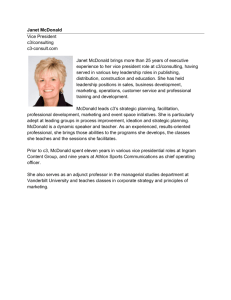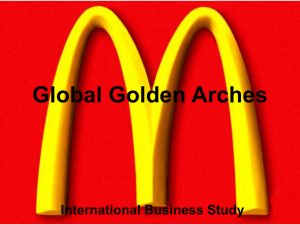Cost of Equity ROE
advertisement
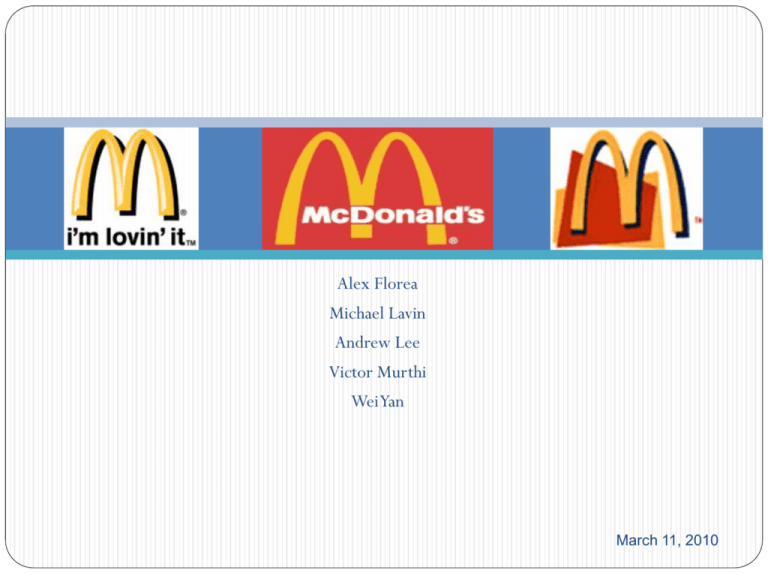
Alex Florea Michael Lavin Andrew Lee Victor Murthi Wei Yan March 11, 2010 Business Overview World’s #1 fast-food chain by sales Competitors: Burger King Holdings, Inc. Yum! Bands, Inc. (KFC, Pizza Hut, Taco Bell, Long John Silver’s, and A&W ) Wendy’s International, Inc. Doctor's Associates, Inc. (Subway) Products: Hamburgers Chicken sandwiches and products French fries Breakfast items Salads Soft drinks Desserts Source: http://www.adamseal.com/Portfolio/?p=261 (Assessed Nov. 15, 2009) Fact Sheet Headquarters: Oak Brook, Illinois 32,478 restaurants in 117 countries (as of Dec. 31, 2009): Serves 58 million customers daily Employs 385,000 people Types of Restaurants Counter and drive-through services Locations: Stand-alone basis in cities and suburban areas Connected to gas stations/convenience stores Shopping malls Wal-Mart stores Truck stops Features indoor and outdoor playgrounds for children Business Model 26,216 (80.72%) franchisee and affiliate operated stores 6,262 (19.28%) company operated stores Collects from franchisees: Initial investment fees Royalties (% of sales) Rent (% of sales) Supply food and materials to restaurants through approved 3rd parties Franchising Down payment (Min. net worth of $.5MM) 25% for existing stores 40% for new locations Financing Established relations with banks facilitate loan Ongoing Fees 4% of Sales Rent: Monthly base rent + % of Sales Geographical Revenue Breakdown Other APMEA 5% (Asia/Pacific, Middle East, Africa) 19% International Revenue United States 35% Europe 41% Macroeconomic Outlook Compete in the high-margin beverages market with "McCafe” Separate niches with McDonald's being the better value proposition and Starbucks offering more of a quality experience Strong International Growth is Driving Sales 65% of sales occur outside of the United States Changes in consumer preferences Consumer preferences continue to gravitate towards healthy meals Providing free Wi-Fi in all U.S. outlets Commodity Costs can Impact Margins Since 2005, food prices have increased substantially, but competition has prevented McDonald's from passing costs along to customers Sensitive to the Dollar Higher translated value Industry Overview The current economic environment has increased consumer focus on value, heightening pricing pressures across the industry Higher commodity prices are driving increases in food costs. Society's increasing awareness of the health risks associated with a high fat, salt and sugar diet. Total market saturation Intense competition Low level of concentration Major Players * Source: WikiInvest – McDonald’s on Feb. 21 2010 SWOT Analysis Strengths: Weaknesses: Viewed as market leader Heavy dependence on commodity cost Bargaining power with suppliers lowers input costs and boosts margins (chicken, beef) U.S. is becoming a saturated market Branded affordability, menu variety, and beverages Expansion and ongoing reinvestment Management practices and controls Opportunities: Threats: Growing beverage category (McCafe, Currency risk smoothies and frappes in 2010) Breakfast menu International expansion (China, Russia, India) Shift in consumer demand (health conscious) 5-Year Historical Performance * Source: Yahoo Finance – McDonald’s on Feb. 21 2010 Recent News March. 15 (Future): Dividend payment of $0.55 / share Feb. 10: Increases in comparable store sales growth for 2009 2.6% increase for United States – driven by continued focus on classic menu favorites, dollar menus, McCafe, and Angus Burger 5.2% increase for Europe 3.4% increase for APMEA Jan. 22: Announced 2009Q4 EPS results of $1.03 (Analyst consensus $1.02) Dec. 30: Unexpected departure of No.2 executive, Ralph Alvarez due to health concerns Management’s Outlook for 2010 Remain focused on “better, not just bigger” strategy Further differentiate brand, increase customer visits, and grow market share through: Service enhancements Restaurant reimaging (about half of the $2.4 billion of planned 2010 capital expenditures) Menu innovation Commodity costs are expected to be relatively flat, but fluctuations between quarters SG&A are expected to remain relatively flat Interest expense is expected to increase slightly compared to 2009 Other half of $2.4 billion CapEx is for the opening of 1,000 new restaurants Close 430 restaurants in Japan; tax impairment charges of $40-$50 million We are confident that management will execute these strategies while remaining disciplined in operations and financial management Key Strategies U.S. Strategies: Strengthen core menu and value offerings Aggressively pursue new growth opportunities in chicken, breakfast, beverages, and snacking options Planned introduction of smoothies and frappes in mid-2010 Europe Strategies: Focus on building market share by: Upgrading restaurant ambiance by end of 2011 (mostly in France and U.K) Leverage technology such as self-order kiosks, hand-held ordering devices, and drive-thru Marketing initiatives APMEA Strategies: Market convenience, core menu, and branded affordability Five-Step DuPont Analysis 2004 2005 2006 2007 2008 2009 EBIT/Sales (operating profit margin) 21% 21% 22% 24% 27% 29% Sales/Assets (asset turnover) Interest/Assets (interest expense rate) 67% 64% 72% 78% 83% 75% 1% 1% 1% 1% 2% 2% 196% 198% 187% 192% 213% 215% 1-tax (tax retention rate) 71% 70% 69% 65% 70% 70% ROE 13% 12% 15% 18% 20% 19% Assets/Equity (equity multiplier) Net Profit Margin Sales per Restaurant Comp. Sales Growth ROE Income Statement Assumptions Forecast Assumptions Growth for company-operated sales Growth for franchised revenues COGS Margin SG&A Margin 2010 2011 2012-2015 2.00% 5.00% 7.00% 10% 11% 12% 62% 62% 62% 9% 9% 9% 30% 30% 30% Income tax rate WACC Calculation Cost of Equity ROE ROE CAPM WACC = ROE WACC = 16.96% 21.32% 40% Cost of Equity CAPM beta 5.04% 0.60 risk-free 2.42% equity premium 5.50% CAPM 5.71% Cost of Debt 4.11% Triangulation = 12.19% 60% Discounted Cash Flow FCFF 3,335.24 3,882.20 4,395.34 4,880.06 5,415.93 6,008.41 6,969.22 Terminal Value FCF Exit Multiple 134,155. 21 75,794.5 9 19.25 Perpetuity Growth Discount Rate 12.19% PV of FCF's 3,335.24 Sum of FCFs 3,460.23 3,491.77 3,455.46 3,418.07 46,015.50 63,176.28 DCF Valuation Perpetuity Exit Growth Multiple PV of Firm 63,176.28 96,005.06 Less Net Debt 12,052.00 12,052.00 Equity Value of Firm 51,124.28 83,953.06 Shares Outstanding 1,077.00 1,077.00 Value per Share 47.47 77.95 Public Comparables Analysis Triangulation & Football Chart P/S P/B P/E DCF $- $20 $40 $60 $80 $100 $120 $140 $160 $180 $200 Value Triangulation Method DCF-Perpetuity Growth DCF-Terminal Value P/E Multiple P/B Multiple P/S Multiple Weighted Per Share Value Value Weight 47.47 77.95 67.11 70.56 68.10 Value 25% 20% 25% 25% 5% 11.87 15.59 16.78 17.64 3.40 65.28 Management Assessment The management has been consistent in its dividend policy: In 2009, the company returned $5.1B to shareholders through a combination of shares repurchased and dividends paid, bringing the three-year total to $16.6B (consistent with management’s $15B - $17B target). Management reviews and analyzes business results in constant currencies however we believe the company has been conservative in hedging the currency risk. Management continues to evaluate opportunities to optimize the mix of franchised and company-owned operations to boost the competitive margin. McCafe had met sales expectations and has benefited from the high level of advertising that McDonald's has committed to it. Coffee sales now make up 5% of McDonald's total sales. We are confident that similar attention will be devoted to developing the rollout of more beverages in 2010. Recommendation Holdings in McDonald’s are currently 200 shares bought at $52.44 Closing price on March 10, 2010 was $64.94 Using a triangulation of the methodologies, the calculated intrinsic value is $65.28 Qualitative factors: MCD is a very attractive company with strong management The stock is at an all time high MCD might outperform the market and its peers during a market correction HOLD, but buy 100 shares if price falls to $60.00
